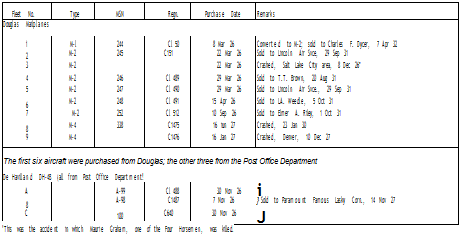Douglas М-2
2 seats *118 mph
|
Loading the mail onto a Boeing 95 ofW. A.E. (see page 22). The pilot was Jimmy James, whose name was inscribed on his airplane. |
|



The Western Fleet
The U. S. Post Office had relied upon the de Havilland DH-4B, a British light bomber design, converted to carry a load of mail; but towards the end of its operating period, the Post Office had tried other types, including the German Junkers-F 13, and it operated the Douglas mailplane. No doubt, Donald Douglas’s proximity—at Santa Monica, only just down the highway from Vail Field—had some influence on Harris Hanshue’s choice of steed for his Four Horsemen. Of the 57 Douglas Mail Planes built, W. A.E. had nine, seven of which were M-2s, and two were M-4s.
WESTERN AIR EXPRESS — THE FIRST FLEET
The Douglas M-2 Mailplane
The Douglas machine was probably the best in its day for its designated task. Its mail compartment, in front of the pilot’s cockpit, was sealed off from the engine by a fireproof wall (a practice that quickly became standard) and was lined with reinforced duralumin. The compartment was six feet long, had a capacity of 58 cubic feet, and could accommodate 1,000 lb of mail. Two removable seats could be installed for hardy passengers, or occasionally for reserve pilots.
The M-2 was developed from the M-l prototype, an action that was famously repeated by Douglas and T. W.A. eight years later. The M-2 was later improved, with the M-3, and later the M-4, with five extra feet of wingspan. Six M-2s were built, and ten M-3s. The reminder (except Western’s two) all went to the United States Post Office Department.
Preserved for Posterity
As described on page 12, one of W. A.E.’s M-4s was carefully restored and donated to Washington’s National Air and Space Museum. It was flown from Long Beach to Washington in May 1977, 46 years after it had crashed in 1930, a striking demonstration of the ruggedness and longevity of the Douglas design.












